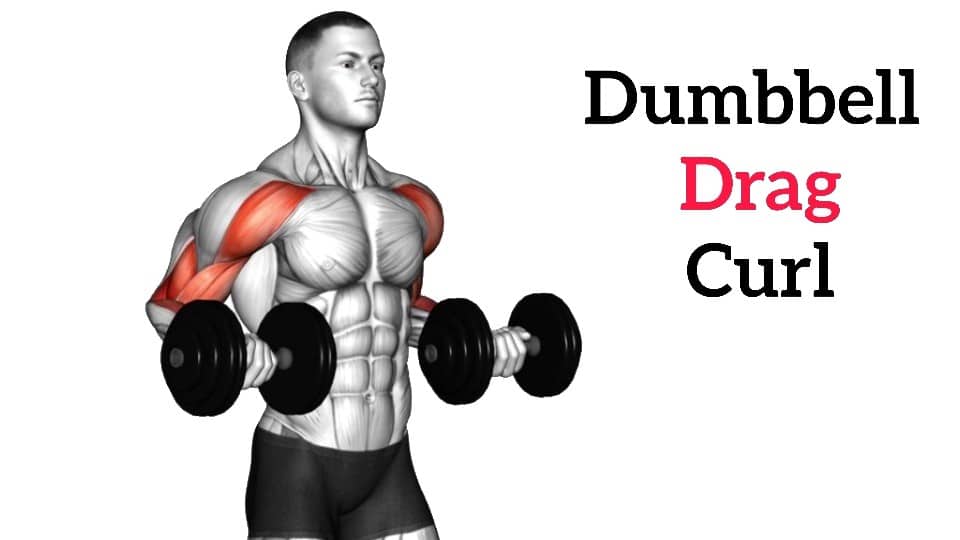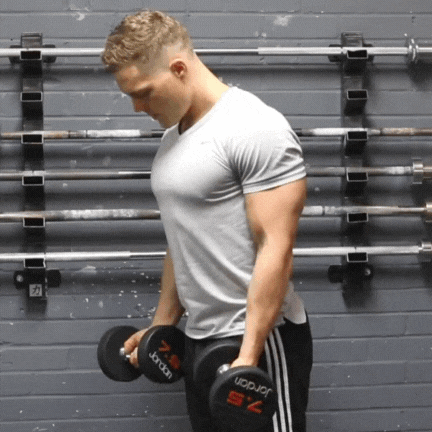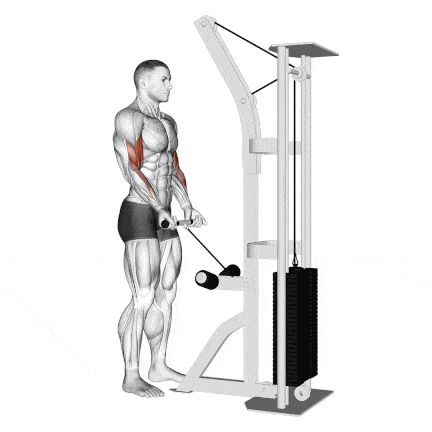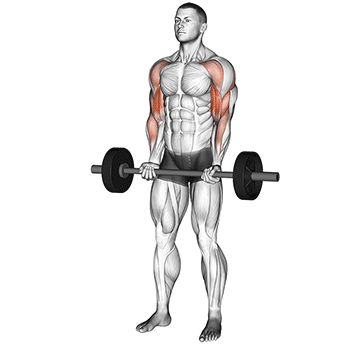The dumbbell drag curl is a unique bicep curl variation in which you don’t completely bring the weight in front of your body. Bodybuilders perform it to improve the size and appearance of their biceps. It primarily targets the long head of the biceps brachii..
Unlike a conventional dumbbell curl, in which the elbows are relatively fixed (or may even drift slightly forward), the Drag Curl actively pulls the elbows back as you lift the dumbbells. The dumbbells literally “drag” up the line of your torso.
The dragging motion eliminates the ability to use momentum or “swing” the weight up, forcing pure muscular contraction.
This posterior elbow displacement significantly reduces the involvement of the anterior deltoid. Why? Because the anterior deltoid is a shoulder flexor. Moving into shoulder extension means moving away from its primary function.
Restricting shoulder flexion causes the biceps to contract more extensively and intensely, resulting in a very strong peak contraction.
When I first heard about the Dumbbell Drag Curl, I wasn’t sure how well it would work. However, after adding drag curls to my workout routine, I saw a big difference in the size of my biceps within 8 weeks.

- Dumbbell Drag Curl Muscles Worked
- How To Do Dumbbell Drag Curl
- Tips and Proper Form
- Set, Reps And Frequency
- Best Variations of Drag Curl
- 1. Single Arm Drag Curl
- 2. Cable Drag Curl
- 3. Barbell Drag Curl
- 4. Hammer Dumbbell Drag Curl
- FAQs
- Are Drag Curls Safe?
- Are drag curls better than bicep curls?
- Why are drag curls so hard?
- References
Dumbbell Drag Curl Muscles Worked
- Primary Muscle: Biceps Brachii (both long and short heads)
- Secondary Muscles: Brachialis, Brachioradialis and Forearm flexors
- Stabilizing Muscles: Deltoids (posterior), Trapezius, Rhomboids and Core (rectus abdominis, obliques, erector spinae)

How To Do Dumbbell Drag Curl

- Stand tall with your chest up and shoulders pulled back and down. For stability, maintain a slight bend in your knees.
- Hold a dumbbell in each hand with an underhand (supinated) grip. Let your arms hang straight down, with the dumbbells resting against the front of your thighs or slightly to the sides.
- Start the movement by flexing your elbows (bending your arms) and simultaneously pulling your elbows backwards.
- Continue curling until the dumbbells are near your lower chest/upper abdomen and you feel a strong peak contraction in your biceps.
- Slowly lower the dumbbells back to the starting position, keeping your elbows slightly back to maintain the “drag.”
- Exhale as you curl the weight up (during the concentric phase). Inhale as you lower the weight (during the eccentric phase).
Tips and Proper Form
- Keep your elbows tight to your sides and high. Don’t let them flare out or move forward. The entire curl path should keep the dumbbells “glued” to your body.
- As you curl, think about pulling your elbows back rather than lifting with your hands or shoulders.
- Lock your shoulders down and back—avoid shrugging or rolling forward. The muscles of your upper back help stabilise the shoulder joint so that the arms can do the work.
- I have consistently observed that clients make more progress when they use weights that feel “too light” compared to their typical curling strength. So start with a lighter weight.
- Keep wrists neutral (in line with forearms) and grip tight to transfer force to the biceps.
- Especially for beginners, use a mirror or trainer’s feedback to ensure your elbow path is correct and your back stays neutral.
- Experiment with different grip variations (neutral or hammer) to see which targets your biceps best.
To Stay Motivated: 150+ Gym Workout Motivational Quotes To Stay Fit
Set, Reps And Frequency
The number of reps you should perform depends on your goals. They may include increasing strength, building muscle mass, and endurance.
- It is best to do around 6–12 reps per set for muscle growth.
- For muscle endurance, do 15- 20+ reps per set.
| Level | Sets | Reps | Frequency |
|---|---|---|---|
| Beginner | 2-3 | 8-12 | 1–2 times per week |
| Intermediate | 3-4 | 8-12 | 2–3 times per week |
| Advanced | 4-5 | 8-15 | 2–3 times per week |
Best Variations of Drag Curl
For more variations, you can perform this drag curl with a barbell, cable, or EZ bar.
1. Single Arm Drag Curl
You can focus on that single working bicep when you perform the drag curl, one arm at a time. This intensified concentration often produces superior muscle activation patterns and a stronger mind-muscle connection.
When you hold a weight in only one hand, your body naturally wants to lean or rotate towards the weighted side. To counteract this, your core muscles must work significantly harder to stabilise your torso and maintain an upright position.
2. Cable Drag Curl
Cable drag curls provide continuous tension on the biceps throughout the entire range of motion because the resistance comes from the cable, which pulls at a consistent angle regardless of arm position.
Many people find that the cable drag curl helps them keep their elbows back and really work their biceps because the cable pulls their hands forward and down, making them work their biceps even harder.
Cable machines often provide a very smooth and fluid resistance profile. This can make it easier to focus purely on the muscular contraction and less on stabilising a free weight.

3. Barbell Drag Curl
The Barbell Drag Curl is a powerful variation that emphasizes strict form, heavier loading, and consistent biceps tension.
Generally, you can lift more total weight with a barbell than with the sum of two dumbbells for most exercises.
The barbell locks your hands into a fixed position (usually shoulder-width or slightly narrower), forcing both arms to work in a perfectly synchronised plane.
It can reduce the tendency for one arm to lag, for elbows to flare unevenly, or for wrists to deviate from the intended path.

4. Hammer Dumbbell Drag Curl
The hammer grip (neutral, palms facing each other) in the hammer dumbbell drag curl shifts more activation to the brachialis and brachioradialis muscles than the traditional supinated grip, which focuses more on the biceps brachii.
For many people, the wrists have a more relaxed, natural alignment with a neutral grip.
FAQs
Are Drag Curls Safe?
The drag curl is considered one of the best free-weight bicep isolation exercises and is also quite safe.
Light to moderate weight is best for performing these exercises. This is a fool-proof form that is quite difficult to do improperly.
The drag curl exercise uses a supinated grip that keeps the wrist in its most secure position, which reduces the chance of tendon damage or impingement in that part of the arm.
Are drag curls better than bicep curls?
Both dumbbells drag curls and traditional bicep curls work the biceps and forearms.
- Dumbbell drag curls can activate the biceps and forearms more effectively and improve grip strength.
- While traditional bicep curls are a straightforward and classic exercise for building bicep strength.
Why are drag curls so hard?
Keeping the dumbbells close and behind the body during the exercise requires increased control and muscle activation, making it a more challenging than traditional bicep curls.
Additionally, the dragging motion of the dumbbells can make the exercise more difficult, especially for those with weaker grip strength.
References
- Nunes, J.P.; Jacinto, J.L.; Ribeiro, A.S.; Mayhew, J.L.; Nakamura, M.; Capel, D.M.G.; Santos, L.R.; Santos, L.; Cyrino, E.S.; Aguiar, A.F. Placing greater torque at shorter or longer muscle lengths? Effects of cable vs. barbell preacher curl training on muscular strength and hypertrophy in young adults. Int. J. Environ. Res. Public Health 2020, 17, 5859
- Coratella, Giuseppe, Gianpaolo Tornatore, Stefano Longo, Nicholas Toninelli, Riccardo Padovan, Fabio Esposito, and Emiliano Cè. 2023. “Biceps Brachii and Brachioradialis Excitation in Biceps Curl Exercise: Different Handgrips, Different Synergy” Sports 11, no. 3: 64. https://doi.org/10.3390/sports11030064

Manish is a NASM-certified fitness and nutrition coach with over 10 years of experience in weight lifting and fat loss fitness coaching. He specializes in gym-based training and has a lot of knowledge about exercise, lifting technique, biomechanics, and more.
Through “Fit Life Regime,” he generously shares the insights he’s gained over a decade in the field. His goal is to equip others with the knowledge to start their own fitness journey.
